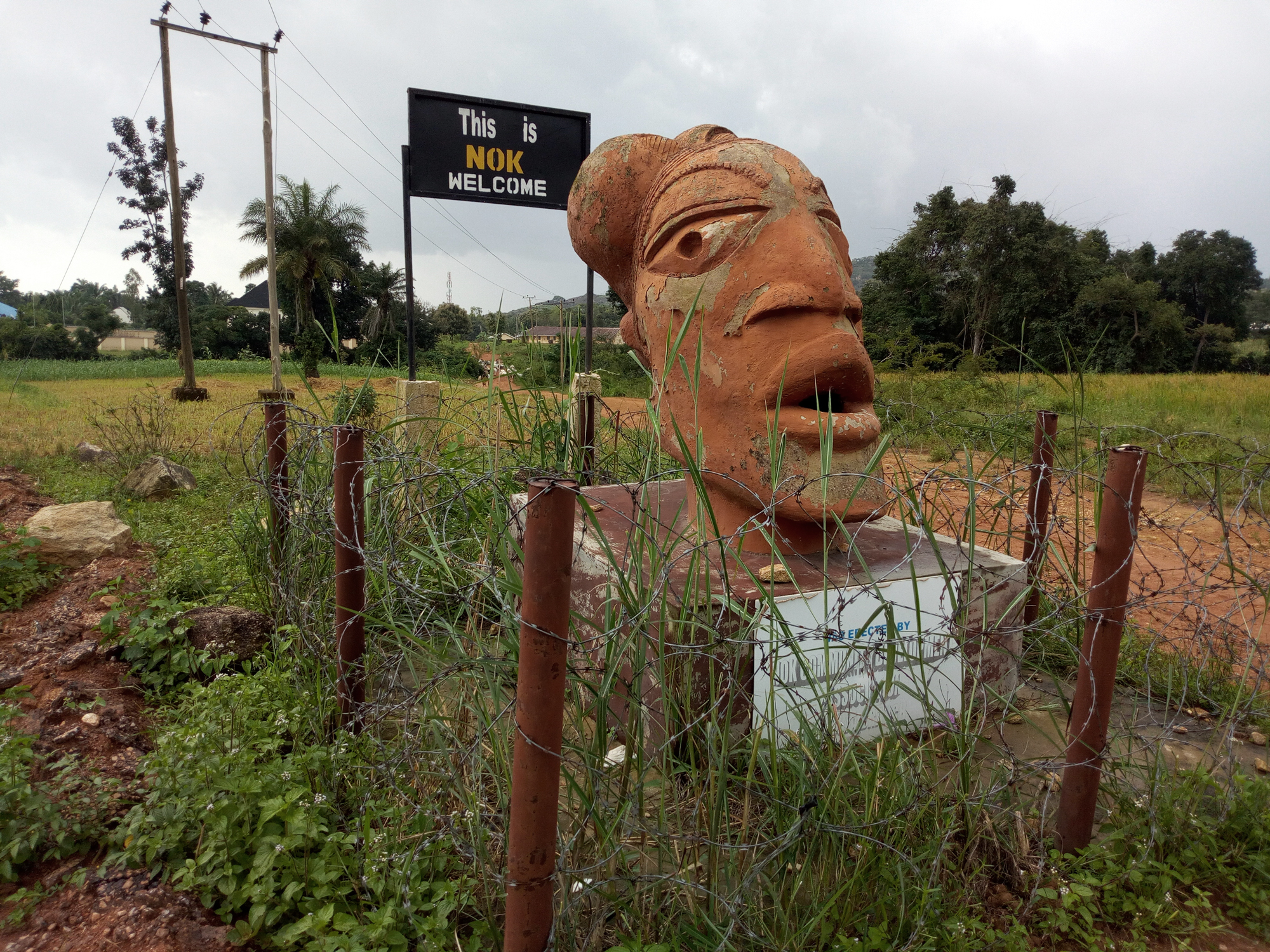Nok terracottas are proof that an ancient civilisation once existed in Nigeria. Now they are at the centre of a multi-million dollar, globe-spanning underground industry. Nigeria loses out.
Outside it has become night. In front of the windows of one of Abuja’s grandest hotels, the pool shines turquoise blue. Finally, the phone rings. It is the hotel’s front desk, announcing a guest.
The man who comes into the room, hours late for the scheduled appointment, is named Umaru Potiskum. He is an art dealer in his late 50s. He’s wearing a dark blue dashiki and is full of self-confidence, but is also suspicious. He knows us as art fundis, and possible buyers, but one of us has also introduced himself as journalist. His is, after all, an underground, illegal business.
“Here I have met many customers,” he says; buyers from Belgium, France, Spain, England and Germany. He shows us what he’s selling, carefully unwrapping two delicate terracotta statues from a piece of cloth.
The eyes gazing out from the ancient clay are triangular, typical of Nok figurines. Over the past decades, thousands of these figurines have been taken out of Nigeria. Many are on display in some of the world’s most prestigious art galleries, including at the Louvre in Paris and Yale University. Many more are no longer displayed, however, because their provenance is questionable.
Anyone who wants to understand what drives this multi-million dollar global trade must go searching: in Abuja and Paris, in Frankfurt and New Haven. But the first stop is the Nok Valley.
A cradle of civilisation
One hundred and fifty kilometres northeast of Abuja, a reddish-brown bush track winds through the lush green of the Nok Valley, towards a village. Mango and palm trees and millet fields surround about three dozen houses and mud huts. Children are running after a hoop, while women chat under the shade of a tree.
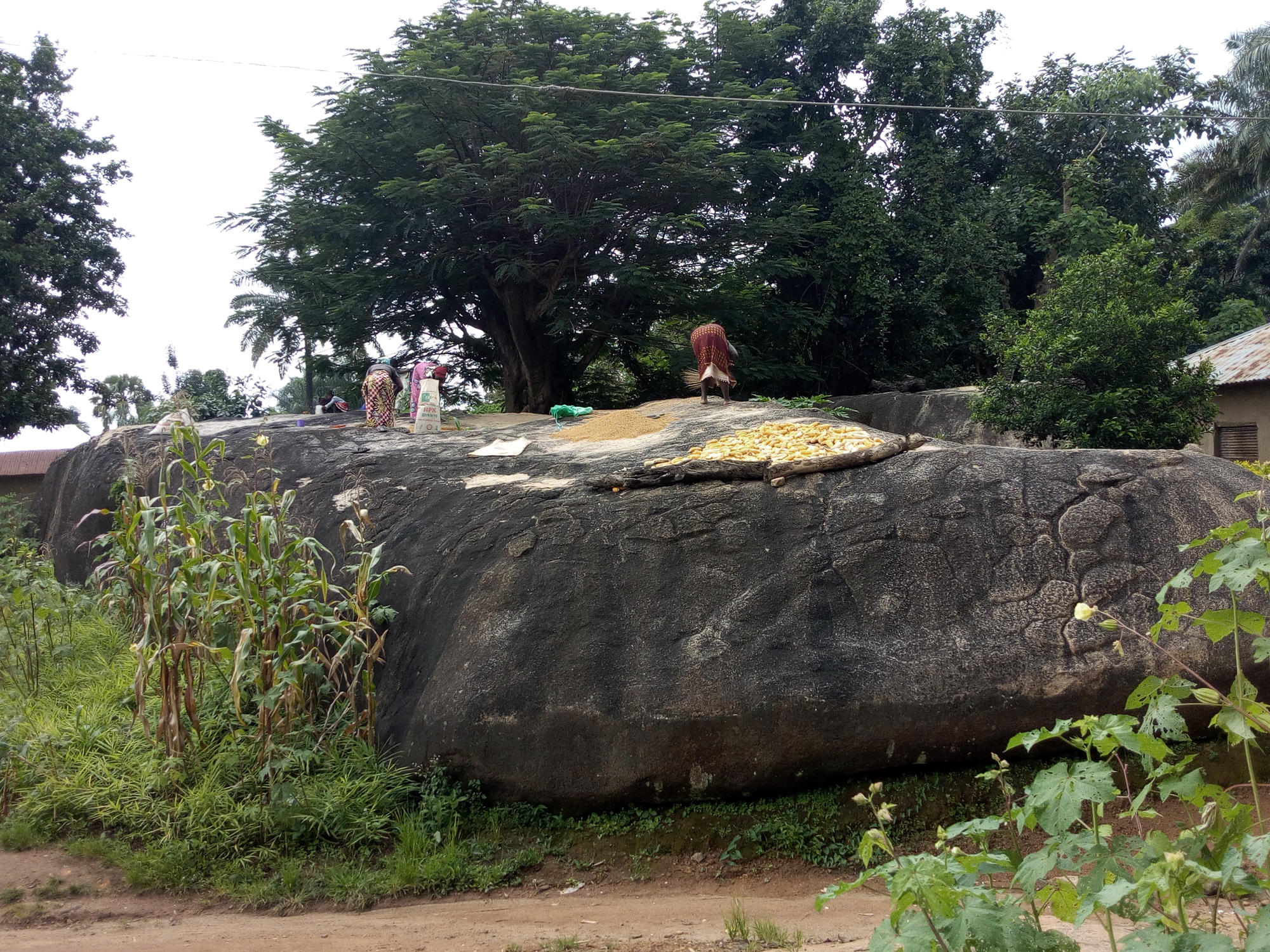
It was here, in 1928, that a foreign miner supposedly discovered the first antique terracotta figure: a monkey head, 10 centimetres high. As archaeologists dug further, they discovered more remnants of an ancient culture, which as per convention they named after the surrounding area: Nok.
From around 1500 BC – at the same time that ancient Greece was flourishing, the Mayan civilisation was developing and Egyptian pharaohs were ruthlessly expanding their empire – a developed society was spreading across the valley, encompassing an area the size of Portugal. It is the earliest known civilisation in West Africa, according to Archaeology magazine.
Between the years of 900 and 300 BC, the Nok produced a staggering number of striking clay figurines, including elaborately stylized people, animals and fantasy creatures, adorned with ornaments, jewelry and symbols. Many appeared to have been buried in shards. Even today these figurines are a riddle: why were they made? What did they mean? Why did so many appear to have been deliberately broken and then buried?
Thousands of figurines have been dug up. But today, it is getting harder and harder to find any more – making them all the more valuable.
The thirsty dealer
At the Abuja hotel, Potiskum takes another drink and starts talking numbers. His two figurines – a man’s head and a larger statue of a woman – are more than 2000 years old, he claims, and any laboratory analysis will prove it. He charges Eur 2,000 for the man’s head, and claims that it can be sold to buyers overseas for ten times that amount. The female figurine goes for considerably more.
These sums would seem astronomical to residents in the Nok Valley, some of whom help to find and dig up the terracottas. They are paid five Euros per day, at most; many earn just one Euro per day.
But that’s how it works, explains Nigeria’s minister for information and culture, Alhaji Lai Mohammed. Nigerian middlemen buy the Nok terracottas at source for a pittance, and then sell them on for a fortune. “We have not yet done enough to stop our own people and to convince them to protect their own cultural heritage,” he says. But given the lack of alternative employment opportunities, the state has found it nearly impossible to control the practice – much to the minister’s frustration. “These works define our history. They define who we are. Those who sell our cultural heritage abroad are harming Nigeria,” he says. He is also critical of the international art market, which seems unable to stop the illicit trade in Nok terracottas once they have left Nigeria.
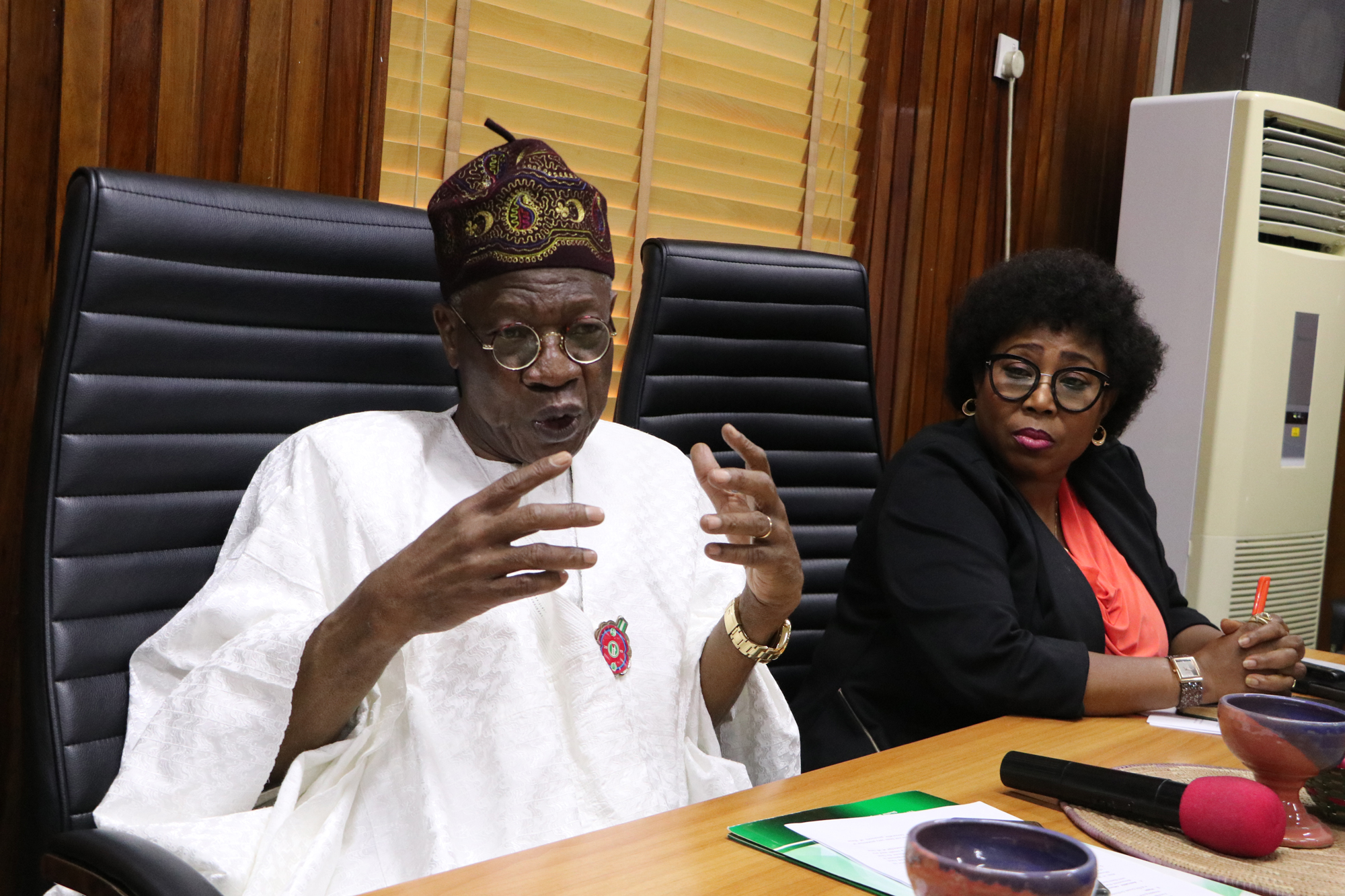
The minister says that the National Commission for Museums and Monuments (NCMM), which is under him, cooperates with the Artefacts Rescuers Association of Nigeria, an organisation of art dealers that purports to protect Nigerian cultural heritage. However, unfortunately the NCMM does not have enough money for rescuers at the moment, he says, and sometimes the sums demanded by the “rescuers” are far too much.
Minister Mohammed does not have an easy job. Nigeria’s population is about 190-million people, and they speak more than 500 languages. The country is a finely woven carpet of religions and ethnicities and cultures, some rooted in emirates and kingdoms whose traditions stretch back for thousands of years. Its borders are arbitrary, drawn up by British colonisers whose understanding of local dynamics was limited at best. Arts and culture are one tool that the government has to bring this diverse nation together, so it does not help when important cultural artefacts keep ending up in other countries.
Potiskum knows a thing or two about those British colonists. His father was a close colleague of Bernhard Fagg, an English archaeologist who worked in the colonial administration in Nigeria from the 1940s to the 1960s. He was responsible for telling the Western academic world about the newly-discovered Nok culture. At the time, “Black Africa” was, in the Western world, widely considered to be a terrain without history; a “heart of darkness” just waiting to be civilised. This myth helped to legitimise the brutal subjugation of the continent by western colonists.
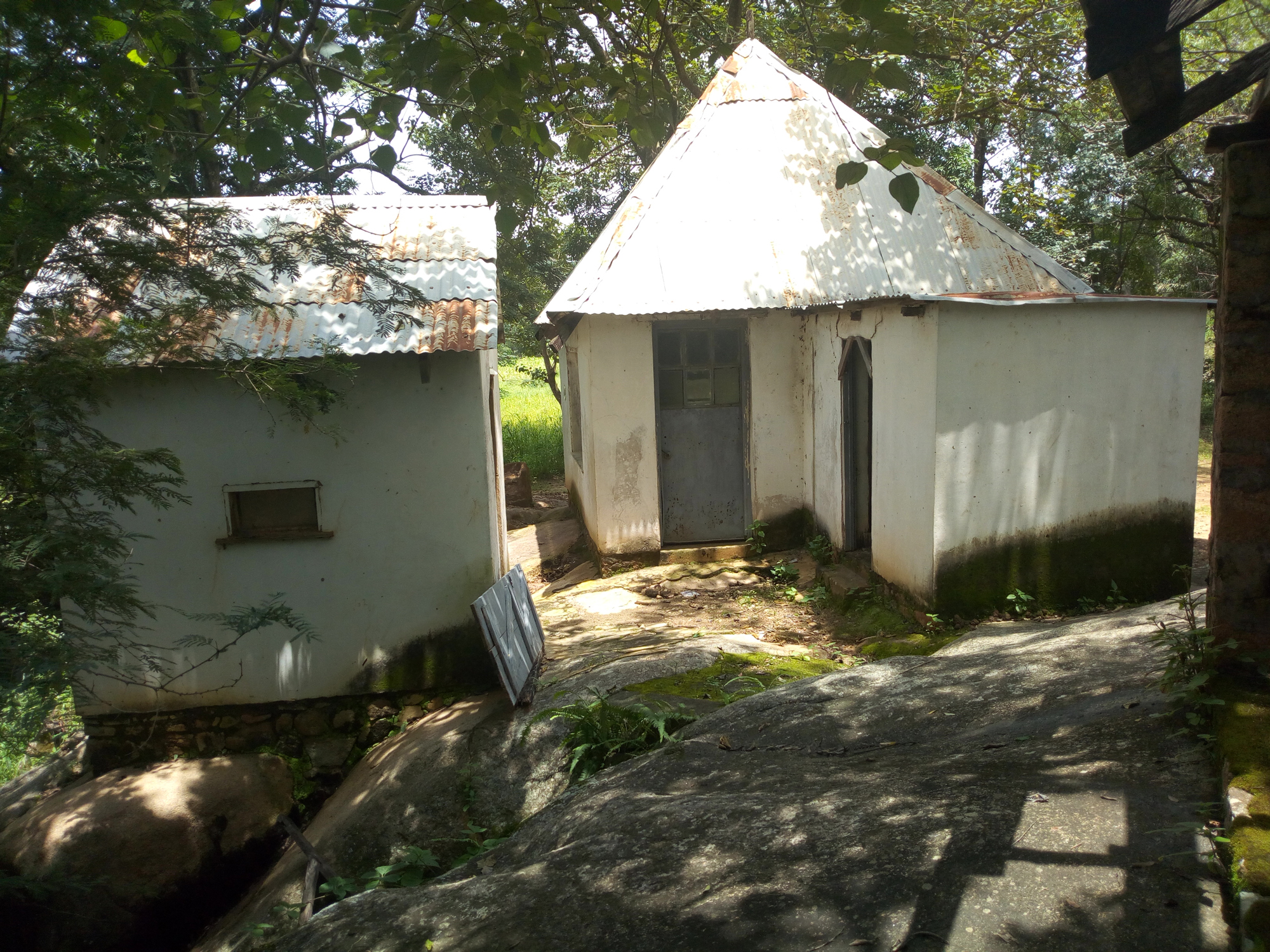
The very existence of the Nok culture challenged that racist narrative. Today, in academic circles, Fagg is still seen as the great pioneer of Nok studies, or even the “discoverer” of Nok culture. And in the Nok valley, in the village of the same name, the house where Fagg once lived is still standing. Sometimes tourists even come to look at it. But if they want to hear nice things about Fagg, they had better not ask Beno Adamu, the village chief.
They never saw their terracottas again
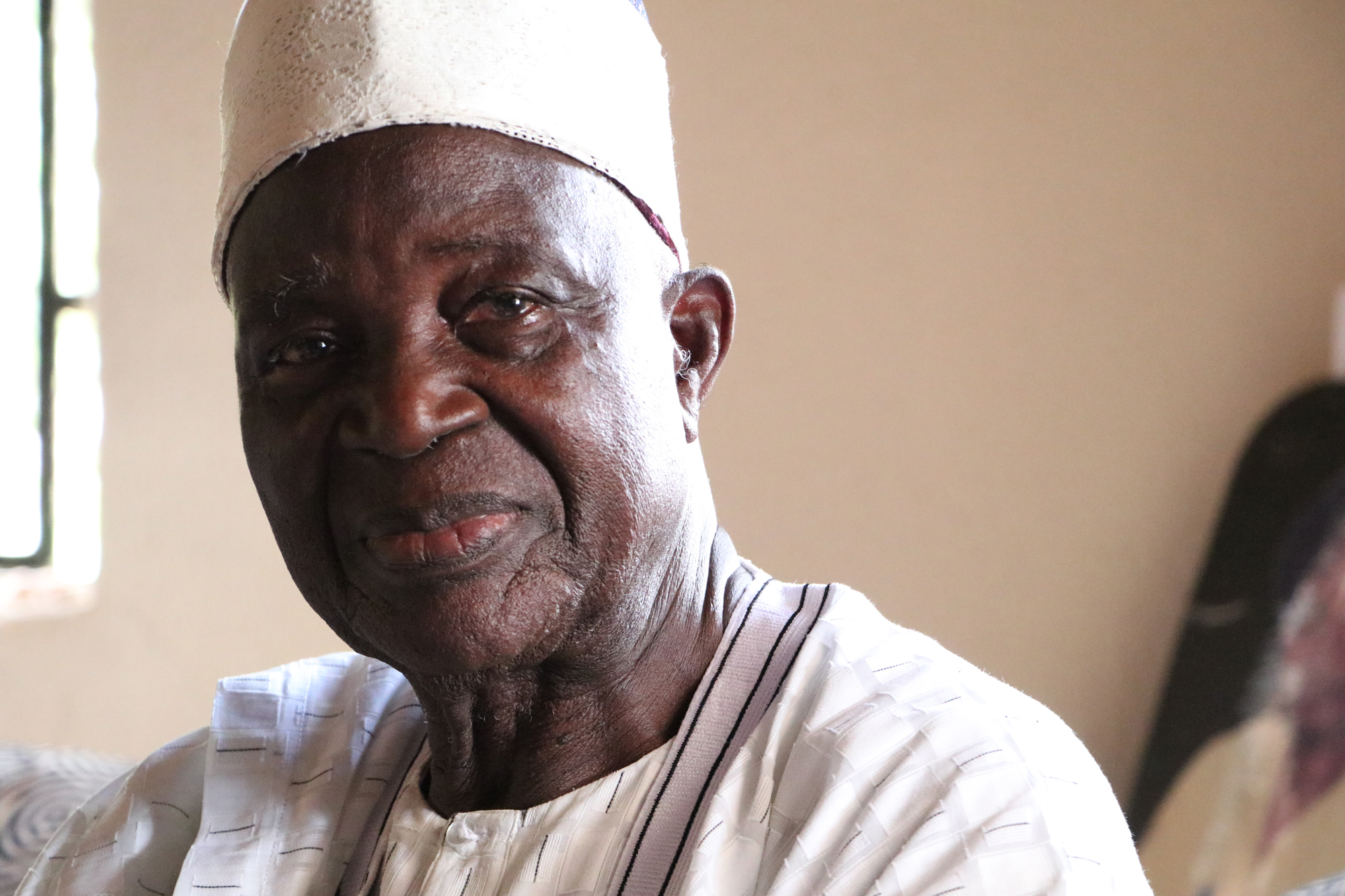
Adamu’s house is made of stone and is located at the entrance of the village, on the left side. Inside the house, the 75-year-old dignitary sits in a big, soft armchair. His memories and knowledge differ greatly from the versions in the history books. He dismisses the notion that the Nok terracottas were “discovered” by foreigners.
“We, Ham people here in Nok, look back at a long, long history and have always known these terracottas. Our grandfathers told us about them.” The Ham people– they are 350,000, live in southern Kaduna and speak the Hyam language-, had them in their shrines, houses and even out in the fields as scarecrows long before Fagg “discovered” them.
Adamu met Fagg a few times, when he was a young boy. He remembers: “Fagg asked the people to bring their terracottas to his house. Which they did. Then he told them that the pieces would be worthless. They never saw their terracottas again. They were already packed.”
Adamu speaks openly about what many people in the village think: “We are warm-hearted people. We like to have guests. But our treasures have been taken away and we do not see them again. Today they are in England, Germany and France. Many people came here, selfish, and used us as cheap labour. Then they disappeared and nobody supported us in our development. Not even our own government. We have not really benefitted from our great heritage.”
Almost every Nok terracotta excavated over the last 50 years has left Nigeria for the international art market. When talking to local government officials in Kaduna State, where the Nok Valley is situated, it becomes clear that there are few systems in place to keep them in the country.
The head of prisons does not know of any inmate who has been imprisoned for illegal digging or smuggling of cultural artefacts. The police chief says that his priorities are kidnappings, banditry and conflict between cattle herders and farmers. He does not have time to worry about the terracottas. The immigration boss has been to workshops about cultural heritage and how to protect it, but has not yet confiscated any smuggled artefacts.
In the hotel room, Umaru Potiskum boasts: “Don't worry, export is no problem. Wherever I have to deliver, I deliver. I just need the address.” He knows the customs people; border guards in Lagos; an international shipping company which helps him. He can even organise the export via other West African countries like Togo, Benin and Ghana. He has a well-functioning network there.
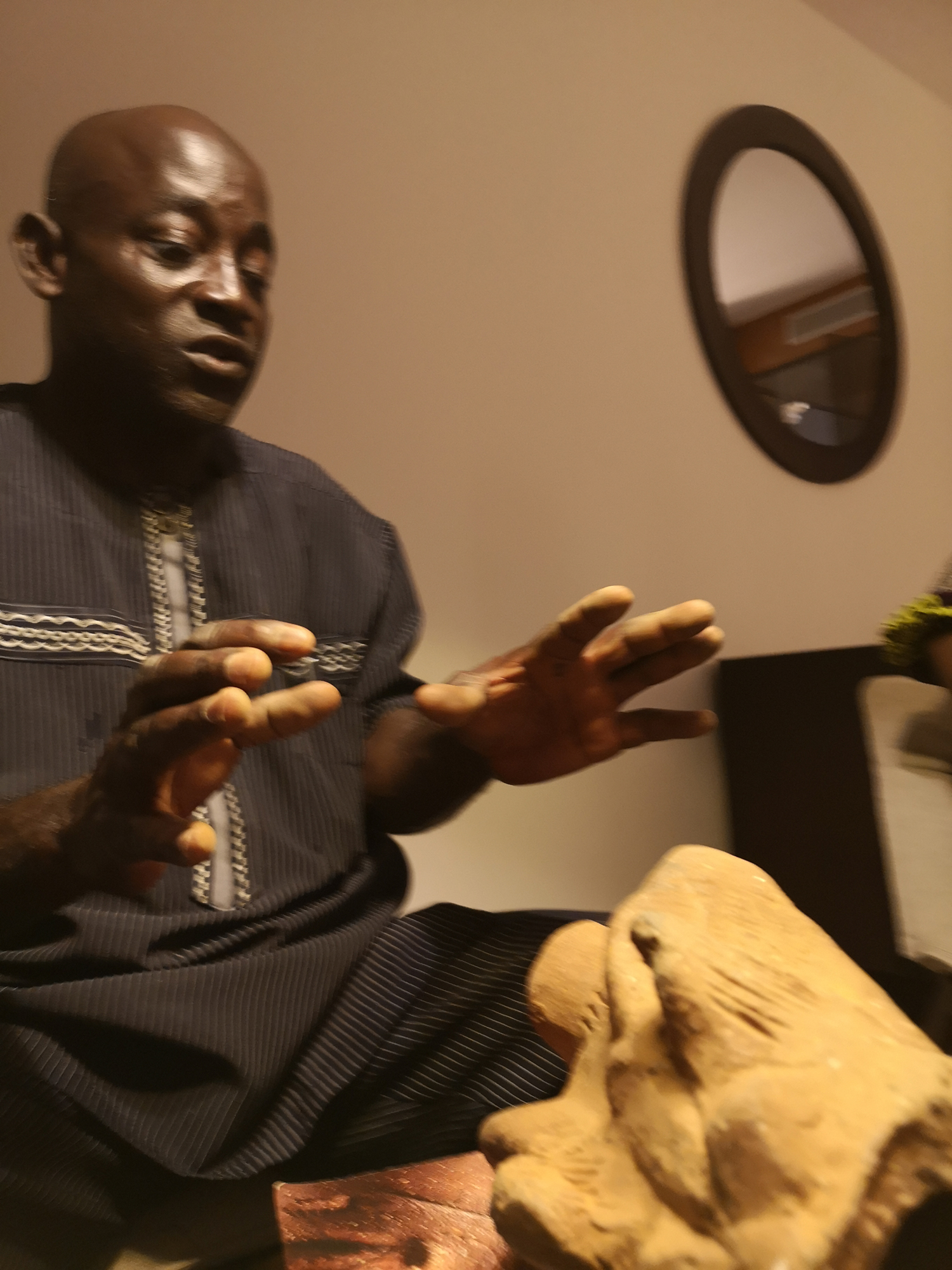
And the export papers? “I can get everything,” he promises. Never mind that he is also a member of the Artefacts Rescuers Association of Nigeria, the organisation of art dealers that purports to protect Nigerian cultural heritage: Potiskum says that it does not pay to remain above the law. He says he once handed over 72 Nok terracottas to the National Commission for Museums and Monuments NCMM, but has not seen a single naira for them – despite the government’s promise to pay for rescued antiques. He claims that the NCMM owes him 65 million naira (about Eur 140,000).
He prefers to deal with foreigners, he says, as he is getting more relaxed, and mentions “my friends Peter Breunig and Nicole Rupp.” Breunig and Rupp are two German archaeology professors from Frankfurt's Goethe University. Between 2005 and 2020 they led an excavation project in Nigeria, which was funded by the German Research Foundation (DFG). But while digging for ancient history, the project opened up new wounds.
The Germans ‘took advantage’
It’s hot in Abuja. 42 degrees Celsius and the air conditioners are working hard. On the second floor of an office tower in Utako, Zachary Gundu enters the meeting room. Gundu is a professor of Archaeology at the Ahmadu Bello University in Zaria. He is a prominent academic; amongst other positions, he was on the council of the World Archaeological Congress.
Everyone knows that archaeologists in Nigeria urgently need international involvement and academic cooperation, he says. But he is not at all happy with how the German team went about it. They did not want to work with Nigerian researchers at the universities in Zaria and Jos, he says. Eventually, “they had to be forced” to work together.
It was only in 2012 that local researchers could get involved in the German project. But even then, according to Gundu, Nigerian professors were given “no significant work.” Even more shocking to Professor Gundu is that the German team seemed happy to work with illegal diggers and criminal art dealers.
Gundu is not alone in his criticism.
In 2012, 20th of June, 48 Nigerian archaeologists from five universities signed a document in which they criticised, among other things, "how the German team took advantage of the ‘institutional weakness’ of the NCMM” to exclude Nigerian archaeologists “from exchange of knowledge and participation in the project.”
They talk of the “unethical practices of the German team,” “the manipulation of local communities,” support for activities “leading to the illegal excavation of archaeological sites” and “unsupervised export” of Nok terracottas. The document was written in support of the actions of the Archaeological Association of Nigeria against the DFG project.
Gundu says that Western intellectuals and international organisations should be collaborating against what he describes as a “post-colonial injustice.” “But Africa is often misused as a laboratory where European scientists just walk in, experiment and collect data with which they can verify their ideas about the continent,” says Gundu. Then these scientists – people like Breunig – are considered to be the global experts on Africa. “He’s now regarded worldwide as the Nok expert.”
The archaeological scandal was covered in Nigerian media, which described the German’s approach as “looting” and “robbery.” But in Germany there was hardly any coverage. Instead, the exhibition, Nok: An Origin of African Culture, which was shown in 2013/14 at the Liebieghaus Sculpture Collection in Frankfurt, was widely reviewed. “How many Nigerians could visit the exhibition? Wouldn't it have been decent to hold such an important exhibition in Nigeria first?" asks Gundu.
His fierce criticism of the Frankfurt project got Gundu into trouble. He received anonymous threats. Did the professor anger powerful opponents in the NCMM? Was he targeted by the “dealers’ cartel,” as he suspects? There are lots of suspicions and rumours.
But things got even more dangerous for Peter Breunig, the German professor. On the morning of 22 February 2017, he was working with his German team and about 80 local employees at an excavation site near the village of Janjala. Suddenly some men with Kalashnikovs appeared. They kidnapped Breunig and one other German man, Johannes Behringer, and demanded a ransom of 60 million naira (Eur 135,000) for their release. They were released three days later, after ransom was paid.
The German team immediately withdrew from the Nok territory. Their research station there – complete with colorful round houses, a big generator and a fish pool – was left orphaned, until it was handed over to the NCMM in January 2020.
Digging up difficult history
Breunig, 68-years-old, sits in his big, light office in the main building of the Goethe University. The professor has an excellent view over the Frankfurt skyline. Many things are clearer now.
There is no doubt that he has secured himself a place in the modern history books of the Nok civilisation. His research has added greatly to what we know about the ancient society. His headline conclusion, after 15 years of research, was that there is no evidence that proves the existence of a spectacular Nok Kingdom. He found no palaces or anything like that.
Instead, Breunig believes the Nok lived in “small mobile farmer groups.” He thinks the terracottas are somehow related to graves, although no bones were found. Maybe the acidity in the earth decomposed everything.
Breunig is “partly thankful” to his Nigerian colleague Gundu for his sharp criticism. Without it, the universities in Jos and Zaria would never have been involved at all. At the beginning, the NCCM, the museums authority, was against any collaboration with local universities – probably because they wanted to install their own people on the project, Breunig speculates.
But he reacts angrily against the accusations made against him by the Nigerian press. “Pure lies! Looting takes place on a wide scale, but never by us,” he said. Each find was carefully documented and, as agreed, returned to Nigeria after the research in the high-tech laboratory in Germany was concluded. In total, his project excavated 100 large terracottas and 3,000 smaller fragments, all of which were later sent to the National Museum in Kaduna.
Breunig knows exactly who Umaru Potiskum is. In fact, he is “very grateful” to the art dealer, and says that without his support the team would have found far less. But he says Potiskum did not stay with the project for long, since the art dealer found far more lucrative opportunities in trading antiques.
It is clear that the line between archeologist and looter is thin, and that the two professions in some ways depend upon each other. Both are looking at what each other is digging up, and whoever wins the race to excavate a precious artefact determines its destiny.
Some end up in the well-guarded hiding places of collectors, and others in small exhibits like in Kaduna. Then there are the ones that end up in the most visited museums in the world.
The smugglers’ charter
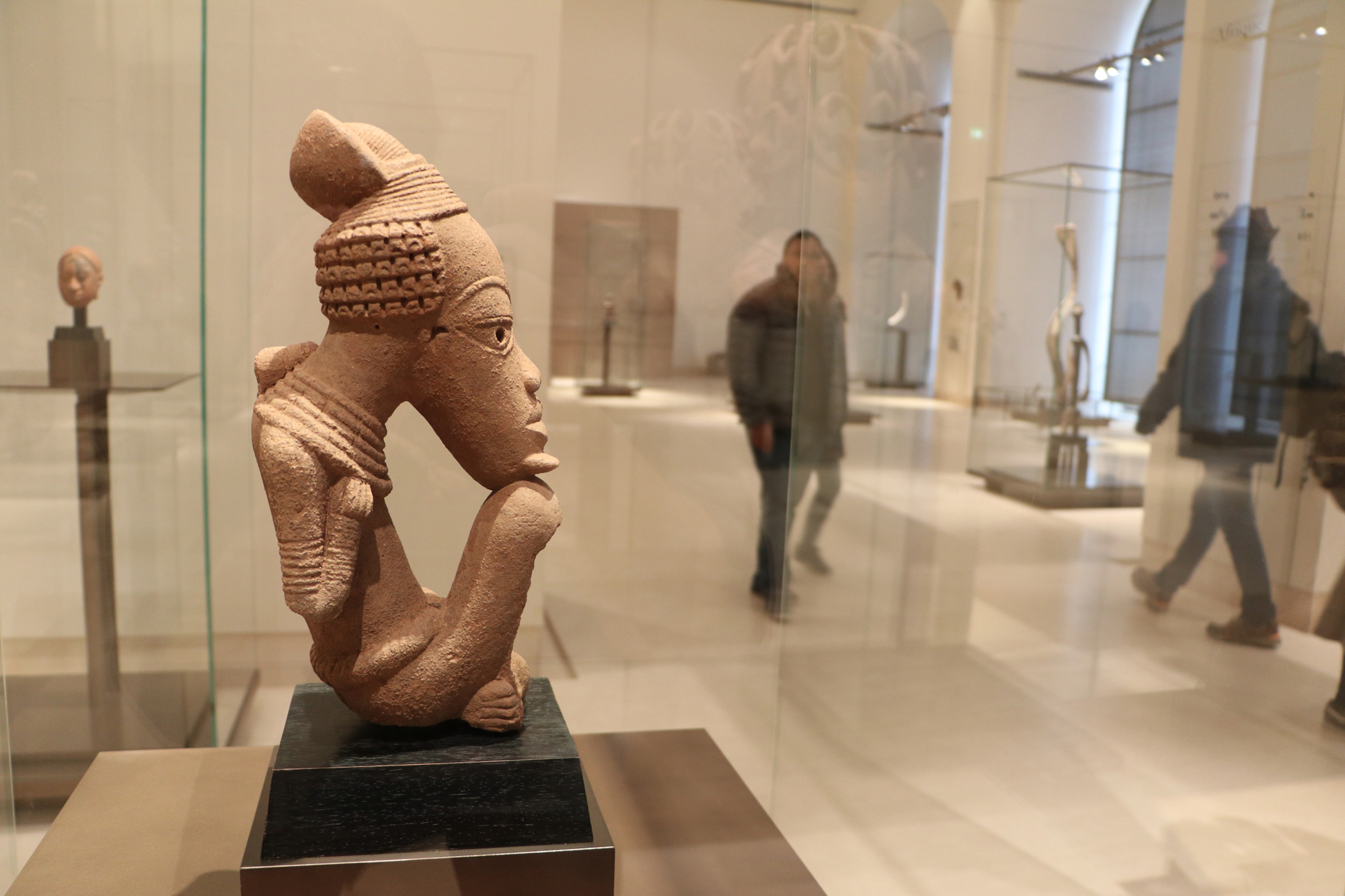
It is a six-hour flight from Abuja to Paris, to visit the Louvre Museum. Ten million people visit the Louvre every year. Here, in the Pavillon des Sessions, two Nok terracottas are displayed. They are as impressive as they are scandalous.
According to Trafficking Culture, an international consortium which analyses illegally acquired art, French officials purchased the works in 1998 from a Belgian dealer for a moderate 2,5 million francs (close to Eur 400,000 today). Immediately afterwards, Nigeria’s military government demanded their return, claiming they were illegally removed from the country.
But the French president at the time, Jacques Chirac, was having none of it. He considered himself to be a great lover of African art, and was in the process of setting up a modern ethnographic museum in Paris which would bear his own name: the Musée du Quai Branly - Jacques Chirac (it is from this very museum that Congolese activist Emery Diyabanza removed a 19th century Chadian funeral earlier this year, exclaiming as he did so that he had “come to claim back the stolen property of Africa, property that was stolen under colonialism”).
Chirac is said to have spoken personally with the newly-elected Nigerian President Olusegun Obasanjo in 1999, and they made a deal. France would recognise Nigeria as the rightful owner of the Nok sculptures. In return, Nigeria would loan the terracottas for 25 years to France, with the option to extend.
Folarin Shyllon, a law professor at the University of Ibadan, called the contracts a “totally unfair smuggler's charter.” He said that when they bought the terracottas, the French must have known they were looted antiques. Buying them anyway was evident of France’s “insistent chauvinism,” Shyllon wrote in the journal Art, Antiquity and Law; and allowing France to keep them showed Nigeria’s “complete lack of national pride.” The deal was “inexplicable” and effectively granted carte blanche for the looting of Nigerian cultural treasures.
Today, things are a little different in France, at least superficially. In 2018, President Emmanuel Macron’s government released the ‘Report on the Restitution of African Cultural Heritage: Toward a New Relational Ethic,’ which argued that unlawfully acquired cultural property should be returned to their lawful owners. The market reacted swiftly: that year, auction houses sold 40% less in the ‘Tribal Art Market’ category than in the year before.
But it is still possible to purchase Nok terracottas in Paris. In fact, it is easy.
For more than a hundred years, the Saint-Germain-des-Prés district of Paris has been a global hub for trade with antique Africana. In the first half of the 20th century, the European avant-garde marvelled at “primitive negro and tribal art” as it was called at that time. The artist Picasso lived here and acquired his own collection of African sculptures. Today there are exhibitions worldwide in which his paintings are shown next to African masks and figures. The similarities are no coincidence.
The ‘Tribal Art’ galleries in the quartier continue to do good business. Since not a single one of our previous interview questions posed to the galleries was answered, we now come as customers. In one shop window, on a pedestal and spot-lit, rests a woman’s head made of clay. It is unmistakably a Nok terracotta. The gallery owner quotes Eur 13,000 for the figurine.
The price, he says, is “very attractive.” No, he does not have all the necessary documentation to show exactly where it came from, although there is a certificate of authenticity showing that it is 2,500 years old, along with the results of a thermoluminescence analysis.
The gallery owner bought the Nok terracotta in West Africa, but not in Nigeria – the country is “far too dangerous,” He says. Instead he mentions Togo and Benin. The terracottas are only going to become more valuable in the coming decades, he concludes, as the history of Nok becomes more familiar to a wider audience.
Four of six Africana galleries visited at random in Saint-Germain-des-Prés sell Nok terracottas of different sizes and quality. Some are sold without export certificates or proof of provenance, and without scientific analyses to date them. The prices range from Eur 4,000 to Eur 20,000. And if you can’t get to Paris, you can also buy them online: at one point the Barakat Gallery website was selling a Nok sculpture for Eur 225,000.
The Yale connection
One of the world's largest Nok collections outside Nigeria can be found in New Haven on the east coast of the United States. The elite Yale University owns dozens of Nok sculptures, some of which are exhibited at the Yale University Art Gallery on Chapel Street. For the noble university's image the Nok terracottas are a delicate matter. Big names and rich donors are involved. That's why the Art Gallery reacts extremely nervously to a visit and questions by journalists.
The New Haven Register, one of the oldest daily newspapers in the US, published one version about the origin of the Nok sculptures in Yale. It reports that the pieces come from Bayard Rustin’s collection. Along with Martin Luther King, Rustin was one of the icons of the black civil rights movement in the US. In 1963, for example, he organised the march on Washington. According to the New Haven Register, Rustin himself acquired the Nok terracottas in the 1950s and 1960s in Nigeria. This is quite possible, because Rustin was a friend of Nnamdi Azikiwe, Nigeria's first president, whom he had met in the USA before Nigeria’s independence. Azikiwe provided him with contacts in Nigeria. After Rustin's death, the Nok terracottas came into the possession of entrepreneur Joel and SusAnna Grae, who donated the collection to the Yale Art Gallery in 2010. Grae had become rich in the nuclear industry, among other trade sectors.
But as usual, history is more complex than a smooth narrative composed around it.. Therefore, who researches will learn that, by far not all of the Nok terracottas at Yale University are from Rustin’s collection. Some gallery staff find that version "frustratingly over simplistic," because the Nok terracottas come from different collectors and many of them have difficult backgrounds.
Around three dozen Nok terracottas from Yale, are listed by the Gallery as “antiquities and archaeological material with provenance documentation gaps.” It could even be that some of the Nok figurines are quite young or forged, from the 1990s. Some pieces are connected to a convicted forger, a dealer from New York with Senegalese background. A gallery employee says that, on the basis of the Nok terracottas, Yale students could learn much about "robbery, forgery and corruption." Since 2020, the Yale University Art Gallery has installed one post for a provenance researcher, who still has a lot of work to do in order to find out about the true origins of the objects.
A blessing and a curse
The internet makes the process of tracking down the provenance of cultural artefacts a little easier. But it can be a curse at the same time, says Sophie Delepierre, who works for the Paris-based International Council of Museums, an umbrella organisation for more than 47,000 museums. She is Belgian and heads the Heritage Protection and Capacity Building department.
On the one hand, online databases bring more transparency, she explains. On the other hand, the online platforms are “a new nightmare,” since nobody can provide a complete overview of these “super-fast businesses worldwide.” Delepierre believes that online markets like Ebay should be responsible for what they trade – just as is the case with ivory.
In the year 2000, her department for the first time published its Red List, which specifies art and artefacts in which trade is restricted or illegal. The list came into existence through a collaboration with UNESCO, the World Customs Organisation and Interpol. Delepierre: “The list does not show single stolen pieces, but objects which stand for a whole problematic context, for instance, the Nok terracotta.”
The existence of the Red List means that dealers, collectors and museums cannot plead ignorance. They know that all Nok terracottas need export certificates and authorisations from their country of origin, so they cannot be surprised when they are later asked to return the object or provide restitution. “The Red List hangs all around the world like a red flag in airports, police stations and at customs,” Delepierre notes. But the illegal art market reacts very flexibly to prohibitions, with new trading routes, clever transport methods and sophisticated fake documents. “We should not be naive. We live in a market economy organised world, and museums are also an industry.” Did her employer, the International Council of Museums, ever kick out a member for unethical behaviour? Delepierre: “Not as far as I know.”
At the Abuja Hotel, art dealer Umaru Potiskum says goodbye. He makes one last promise, telling us that, in future, he can acquire even more than just antique Nok terracottas: centuries-old Ajami scripts, millenia-old Calabar ceramics. Anything. No problem, he says, and disappears into the night.
The investigation was supported by the German journalism association “Hard work and courage” and its Cartographers Program for journalists.

